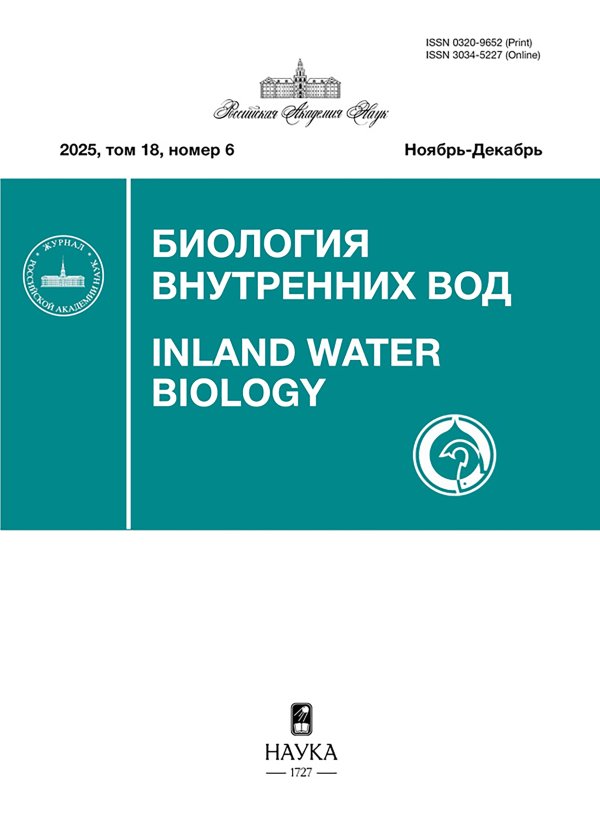Mycobiota of Dead Reed Fragments Immersed in Water (Yaroslavl Region, Russia)
- Authors: Voronin L.V.1, Kopytina N.I.2
-
Affiliations:
- Ushinsky Yaroslavl State Pedagogical University
- Papanin Institute for Biology of Inland Waters, Russian Academy of Sciences
- Issue: No 1 (2023)
- Pages: 20-27
- Section: ВОДНАЯ МИКОЛОГИЯ
- URL: https://journals.rcsi.science/0320-9652/article/view/134880
- DOI: https://doi.org/10.31857/S0320965223010199
- EDN: https://elibrary.ru/KTQNJP
- ID: 134880
Cite item
Full Text
Abstract
The mycobiota on dead submerged plant parts of Phragmites australis reed (leaves, stems, leaf sheaths) was studied in lakes – Pleshcheyevo, Mostetskoye, a lake in the Zavolzhsky district of Yaroslavl and the Kotorosl river (Yaroslavl region, Russia). The kingdom Fungi is represented by 53 species belonging to 33 genera, 25 families, 12 orders, and 7 classes in 2 taxonomic phyla: Mucoromycota (4 species), Ascomycota (48). The kingdom Chromista (fungi-like organisms) includes 8 species belonging to 3 genera, 2 families, 2 orders, and 1 class under phylum Oomycota. For the first time, 23 species of micromycetes were found on reeds. Representatives of the orders Pleosporales (16 species), Helotiales (11), Saprolegniales (7), Hypocreales (5) prevailed. The number of species of fungi on fragments of plants in different aquatic bodies varied from 16 to 39, the statistically significant difference in the species composition of communities of dead reeds was found between a lake in the Zavolzhsky district of Yaroslavl and the Kotorosl River (R = 0.646, significance level of sample statistic 0.1%).
About the authors
L. V. Voronin
Ushinsky Yaroslavl State Pedagogical University
Email: kopytina_n@mail.ru
Russia, Yaroslavl
N. I. Kopytina
Papanin Institute for Biology of Inland Waters, Russian Academy of Sciences
Author for correspondence.
Email: kopytina_n@mail.ru
Russia, Nekouzskii raion, Yaroslavl oblast, Borok
References
- Воронин Л.В. 2010. Микобиота малых озер тундровой и лесной зон. Ярославль: Изд-во ЯГПУ.
- Воронин Л.В., Жданова С.М. 2021. Поражение микопаразитами ветвистоусого рачка Daphnia cucullata (Crustacea, Cladocera, Daphniidae) в оз. Плещеево (Ярославская обл., Россия) // Биология внутр. вод. № 6. С. 655.https://doi.org/10.31857/S032096522106019X
- Голуб В.Б., Бондарева В.В., Сорокин А.Н., Николайчук Л.Ф. 2015. Сообщества с доминированием тростника (Phragmites australis agg.) в долине Нижней Волги // Растительность России. № 26. С. 26. https://doi.org/10.31111/vegrus/2015.26.26
- Дзюба Е.В., Кондратов И.Г., Майкова О.О. и др. 2020. Водные плесени порядка Saprolegniales (Oomycota) в ассоциации с байкальскими видами рыб и губок // Изв. РАН. Сер. биол. № 5. С. 526. https://doi.org/10.31857/S0002332920040050
- Милько А.А. 1979. Систематика рода Saprolegnia // Микол. и фитопатол Т. 13. Вып. 4. С. 288.
- Обухова О.В., Ларцева Л.В., Васильева Л.М. 2017. Особенности сапролегниоза икры судака (Sander lucioperca) в дельте р. Волги // Вестник АГТУ. Сер. Рыб. хоз-во. № 2. С. 70. https://doi.org/10.24143/2073-5529-2017-2-70-79
- Попов Е.С., Коваленко А.Е., Гапиенко О.С. и др. 2012. Микобиота Белорусско-Валдайского поозерья. Моcква; Санкт-Петербург: Тов-во науч. изд. КМК.
- Тобиас А.В., Балашова Н.Б., Киселев Г.А. 2016. Материалы к изучению микромицетов заказника “Лебяжий” (Ломоносовский район Ленинградской области) // Вестник СПбГУ. Сер. 3. Вып. 4. С. 37. https://doi.org/10.21638/11701/spbu03.2016.403
- Черняковская Т.Ф., Воронин Л.В. 2017. Изучение таксономического состава грибов на разлагающихся в озере Плещеево листьях тростника обыкновенного // Экология и рациональное природопользование: Матер. Всерос. науч.-техн. конф. Ярославль: Ярослав. гос. ун-т им. П.Г. Демидова. С. 164.
- Abdel-Aziz F.A. 2008. Diversity of aquatic fungi on Phragmites australis at Lake Manzala, Egypt // Sydowia. V. 60(1). P. 1.
- Abdel-Aziz F.A. 2016. Freshwater fungi from the river Nile, Egypt // Mycosphere. V. 7(5). P. 741.
- Al-Saadoon A.H., Al-Dossary N. 2014. Fungi from submerged plant debris in aquatic habitats in Iraq // Int. J. Biodiversity and Conservation. V. 6(6). P. 468. https://doi.org/10.5897/IJBC2013.0657
- Angelini P., Rubini A., Gigante D. et al. 2012. The endophytic fungal communities associated with the leaves and roots of the common reed (Phragmites australis) in lake Trasimeno (Perugia, Italy) in declining and healthy stands // Fungal Ecol. V. 5(6). P. 683.
- Apinis A.E., Chesters C.G.C., Taligoola T.K. 1972. Colonization of Phragmites australis by Fungi // Nova Hedwigia. Bd 23. Hf. 1. P. 113.
- Clarke K.R., Gorley R.N., Somerfield P.J., Warwickb R.M. 2014. Change in marine communities: An approach to statistical analysis and interpretation. Plymouth: PRIMER-E.
- Crocker E.V., Karp M.A., Nelson E.B. 2015. Virulence of Oomycete pathogens from Phragmites australis-invaded and noninvaded soils to seedlings of wetland plant species // Ecology and Evolution. V. 5(11). P. 2127. https://doi.org/10.1002/ece3.1468
- Devi G. 2018. Utilization of Nematode Destroying Fungi for Management of Plant-Parasitic Nematodes – A Review // Biosci. Biotechnol. Res. Asia. V. 15(2). P. 377. https://doi.org/10.13005/bbra/2642
- DeVries A.E., Kowalski K.P., Bickford W.A. 2020. Growth and behavior of north american microbes on Phragmites australis leaves // Microorganisms. V. 8. 690.
- Dharmendra K. 2017. Genomic insights into the adaptation to parasitism in nematode – trapping fungi and transcriptomics during infection of Caenorhabditis briggsae and plant-parasitic nematodes // Indian Phytopath. V. 70 (1). P. 32. https://doi.org/10.24838/ip.2017.v70.i1.48986
- Ellis M.B. 1971. Dematiaceous Hyphomycetes. Commonwealth Mycological Institute, Kew, Surrey, England.
- Ellis M.B. 1976. More dematiaceous Hyphomycetes. Commonwealth Mycological Institute, Kew, Museum Surrey, England.
- Ghorbani-Choboghlo H., Khosravi A.R., Sharifzadeh A. et al. 2014. Gastrointestinal microflora of captured stellate sturgeon (Acipenser stellatus Pallas, 1771) from Southeast Caspian Sea, Iran // Iranian J. Fish. Sci. V. 13(2). P. 319.
- Index Fungorum 2021 – Index Fungorum [Internet]. Royal Botanic Gardens Kew. Available from http://www.indexfungorum.org/names/Names.asp (Accessed on November 01–30, 2021).
- Likar M., Dolinar N., Vogel-Mikuš K. et al. 2018. Elemental composition and fungal colonisation of decomposing Phragmites australis (Cav.) Trin. ex Steud. litter at different water regimes // Acta Biologica Slovenica. V. 61. V. 61(2). P. 71.
- Luo J., Yin J., Cai L. et al. 2004. Freshwater fungi in Lake Dianchi, a heavily polluted lake in Yunnan, China // Fungal Diversity. V. 16. P. 93. https://hdl.handle.net/10722/223486
- Mazurkiewicz-Zapałowicz K., Wrobel M., Silicki A., Wolska M. 2006. Studies on phytopathogenic and saprotrophic fungi in rush associations of Lake Glinno (NW Poland) // Acta Mycologica. V. 41(1). P. 125. https://doi.org/10.5586/am.2006.016
- Mazurkiewicz-Zapałowicz K. 2010. Microscopic fungi of Phragmites australis in the littoral of two Lakes in Drawa National Park (NW Poland) // Polish Botanical Journal. V. 55(2). P. 381. http://bomax.botany.pl/cgi-bin/pubs/data/article_pdf?id=2246
- Muhsin T., Abgui-Kadir M. 1995. Ecology of fungi associated with Phragmites australis in Iraq // Abhath al-Yarmouk. V. 4(1-a). P. 31.
- Neubert K., Mendgen K., Brinkmann H., Wirsel S.G.R. 2006. Only a Few Fungal Species Dominate Highly Diverse Mycofloras Associated with the Common Reed // Applied and Environmental Microbiology. V. 72(2). P. 1118. https://doi.org/10.1128/AEM.72.2.1118-1128.2006
- Poon M.O.K., Hyde K.D. 1998. Biodiversity of intertidal estuarine fungi on Phragnates at Mai Po marshes, Hong Kong // Botanica Marina. V. 41. P. 141. https://doi.org/10.1515/botm.1998.41.1-6.141
- Sangiorgio F., Basset A., Pinna M. et al. 2007. Ecosystem processes: litter breakdown patterns in Mediterranean and Black Sea transitional waters // Transit. Waters Bull. V. 3. P. 51.https://doi.org/10.1285/i1825229Xv1n3p51
- Sutton B.C. 1980. The Coelomycetes. Fungi Imperfecti with pycnidia, acervuli and stromats // CMI. Surrey. Kew.
- Taligoola T.K., Apinis A.E., Chester C.G.C. 1972. Microfungi colonizing collapsed aerial parts of Phragmites communis Trin. in water // Nova Hedwigia. V. 23. P. 465.
- Van Ryckegem G. 2005. Fungi on common reed (Phragmites australis): fungal diversity, community structure and decomposition processes. Ghent: Ghent University.
- Van Ryckegem G., Verbeken A. 2005a. Fungal ecology and succession on Phragmites australis in a brackish tidal marsh. I. Leaf sheaths // Fungal Diversity. V. 19. P. 157.
- Van Ryckegem G., Verbeken A. 2005б. Fungal ecology and succession on Phragmites australis in a brackish tidal marsh. II. Stems // Fungal Diversity. V. 20. P. 209.
- Van Ryckegem G., Verbeken A. 2005в. Fungal diversity and community structure on Phragmites australis (Poaceae) along a salinity gradient in the Scheldt-estuary (Belgium). Nova Hedwigia. V. 80(1–2). P. 173.
- Voronin L.V., Kopytina N.I., Bocharova E.A. 2021. Checklist of fungi and fungi-like organisms on common reed Phragmites australis // Asian Journal of Mycology. V. 4(2). P. 67. https://doi.org/10.5943/ajom/4/2/7
- Wirsel S.G.R., Leibinger W., Ernst M., Mendgen K. 2001. Genetic diversity of fungi closely associated with common reed // New Phytologist. V. 149. P. 589.
- Wirsel S.G.R., Runge-Froböse C., Ahren D.G. et al. 2002. Four or more species of Cladosporium sympatrically colonize Phragmites australis // Fungal Genet. Biol. V. 35(2). P. 99. https://doi.org/10.1006/fgbi.2001.1314
- Woudenberg J.H.C., Hanse B., van Leeuwen G.C.M. et al. 2017. Stemphylium revisited // Studies in Mycology. V. 87. P. 77. https://doi.org/10.1016/j.simyco.2017.06.001












